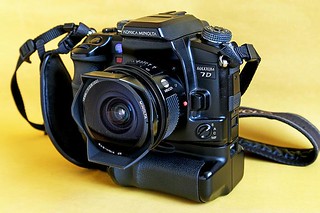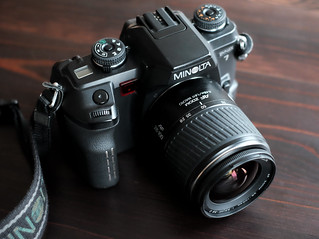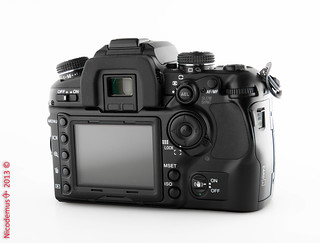Konica Minolta Dynax 7D

|
| As Maxxum 7D; with battery grip image by Marcello Sokal (Image rights) |

|
| image by Nobby knipst (Image rights) |

|
| Konica Minolta Dynax 7D image by Nicodemus Roger (Image rights) |

|
| Konica Minolta Dynax 7D image by maoby (Image rights) |
The Konica Minolta Dynax 7D (called Maxxum 7D in the USA and alpha-7 DIGITAL in Japan) is a 6.3 megapixel single lens reflex digital camera (DSLR) for autofocus lenses. It features the world’s first dslr-body-integral CCD-shift Anti-Shake (camera-shake compensation), based on piezo actuators. The 7D features a high-definition 2.5-inch color LCD monitor and is compatible with Minolta's and Sony's A mount lenses.
In its handling and picture quality, the 7D was widely praised. But a number of its earlier buyers experienced problems such as repeated "Error 58" messages or backfocus. In the period when these defects were covered by warranty, Konica Minolta had high costs — perhaps one of the reasons for its abandoning of its long camera business tradition. The system flashes for the Minolta Dynax SLR bodies can be used with the 7D.
Links
- Konica Minolta Dynax 7D user manual at Manualslib
- Dynax Digital Forum (archived)
- Maxxum 7D Review (archived) at Luminous Landscapes
- Konica Minolta Maxxum 7D Review at dpreview.com
| Japan Camera Grand Prix | |
|---|---|
| Camera of the year
1984: Nikon FA | 1985: Minolta α-7000 | 1986: Canon T90 | 1987: Canon EOS 650 | 1988: Kyocera Samurai | 1989: Nikon F4 | 1990: Canon EOS 10 | 1991: Contax RTS III | 1992: Pentax Z-1 | 1993: Canon EOS 5 | 1994: Minolta α-707si | 1995: Contax G1 | 1996: Minolta TC-1 | 1997: Nikon F5 | 1998: Pentax 645N | 1999: Minolta α-9 | 2000: Canon EOS-1V | 2001: Minolta α-7 | 2002: Canon EOS-1D | 2003: Canon EOS-1Ds | 2004: Nikon D70 | 2005: Konica Minolta α-7 Digital | 2006: Nikon D200 | 2007: Pentax K10D | 2008: Nikon D3 | 2009: Canon EOS 5D Mark II | 2010: Olympus Pen E-P1 | 2011: Pentax 645D | 2012: Nikon D800 | 2013: Sony DSC-RX1 | 2014: Nikon Df | 2015: Canon EOS 7D Mark II | 2016: Sony α7R II | 2017: Olympus OM-D E-M1 Mark II | 2018: Sony α9 | 2019: Lumix S1R | 2020: Sony α7R IV | 2021: Sony α1 | 2022: Nikon Z9 | 2023: Sony α7R V Special Prize Editor | |